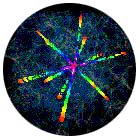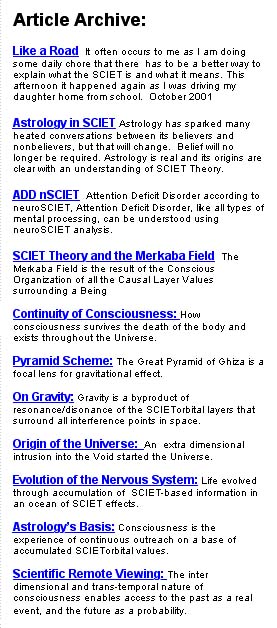Travel by Frequency
Humans can travel to locations that are are dozens of light years away without enduring years in deep space
Can we travel faster than Light?
Several SCIET-based explanations can be offered. The first is simple. Devise a means to step outside of ``space" by using the fabric of space to block itself. In SCIET terms the Relationship interferes with itself to create a region free of any effects from materiality, the Creation Substance without any Hierarchical formating or Capacitance Lattice effects.
Most people have heard of Warp Drive from Star Trek. Warping space is an idea that treats the fabric of space like a substance that is in its way. The objective is to move the fabric of space from the front of the vehicle to the back of the vehicle without the vehicle actually entering the fabric of space. This system pushes against the fabric of space to move and because it is not in the fabric of space it can achieve much higher rates of speed. It steps out of space, but still treats space like it is a fluidic medium rather than a SCIET Lattice frequency environment. Warp drive is useful because it alows forward travel and does not need an assigned frequency destination.
Once we learn to block those frequencies we can then develop a means to define the frequency of the fabric of space at different locations. Then with the ability to ``part" space like a curtain, we can define what frequency the fabric of space is on the other side of the curtain. Part the curtain, pass through and be at the destination defined by the fabric of space.
So, although, the speed of light is a barrier to movement through the fabric of space, transport through space can be done in other ways. Instead of actual forward travel toward a destination, it is possible to use frequency resonance to relocate by changing a frequency to match a distant location. A wide range of applications for travel can be developed, varying from programmable personal sized stargates and jumpgates to moon sized ones for fixed interstellar jumps .
Jumpgates from one part of a country to another as well as to other planets and moons are fixed tranciever sets, meaning that they are tuned only to one another, while it is also possible to build networks that link peer to peer, ala StarGate, The Series. This technology requires that you be physically at the destination in order to implement it.
Interstellar travel can be enabled several ways.
Space vessel-sized stargates between trading partners are practical using a moon sized spherical barrier with a very high frequency shell with another on the inside. The outer shell is tuned to its physical location and the inner shell is tuned to its destination. Ships entering the spherical shell arrive at their destination without any obvious change onboard, simply appearing at the distant site. Since the shell is based on hyperfrequencies, it is not interactive except with specially tuned vessels. However, since it is based on stargate principles it is limited to movement between existing locations.
True interstellar exploration is enabled when a ship has the ability to surround itself with a fabric of space frequency and control its interaction with the fabric of space. With such a technology there are several navigation/propulsion techniques. It can control its gravitational attraction to a planet or shift the frequencies to another region of space. This technology can be likened to the ability of a porpoise to disappear and reappear at a different location without being seen on the surface. Activating the ship's fabric of space frequency control system would be the equivalent of entering the water of the ``fabric of space", providing both the ability to move within a planet's gravitational field and the abilty to exclude it and travel to any other addressable point.
Exploration precedes development regardless of technology,and such porpoise-class ships are always the vangard of emerging space cultures.
Maybe our break-away civilization is already doing it! Or not.
|




